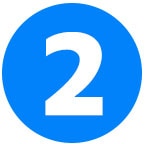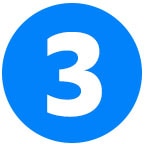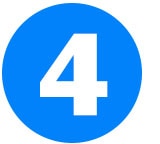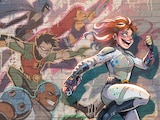Picture in your mind the definitive Justice League comic book cover. Which one do you see? I would be willing to bet that a lot of you pictured either Mike Sekowsky and Murphy Anderson’s cover for The Brave and the Bold #28 (the first appearance of the team!), George Pérez’s cosmic cover for Justice League of America #217, Kevin Maguire and Terry Austin’s cover for 1987’s Justice League #1, Howard Porter and John Dell’s cover for JLA #1, or Jim Lee and Scott Williams’s cover for the New 52’s Justice League #1.
If you pictured none of these, fear not. Your mental image of the Justice League may depend on your age or the comics you gravitated towards first. With Justice League Unlimited #1 on the horizon with its stylish Dan Mora cover, we thought the time was right to take a look back at some of the Justice League covers that changed the way that we see the DC Universe’s premiere team. After all, as the team’s lineup has changed throughout the years, so has what the team represents to readers. The below five covers all had something powerful to say about what we could expect from the book’s team as well as what they were willing to fight for.


Justice League of America #21
This issue from 1963 is a landmark in the history of the DC Universe. As you might know, DC’s first super team was the Justice Society of America, featuring the likes of Black Canary, Doctor Fate, Hourman, Hawkman, Alan Scott’s Green Lantern, Jay Garrick’s Flash and Al Pratt’s Atom. The JSA was DC’s main superhero team during the Golden Age of Comics. But once comics entered the Silver Age in the 1960s, the JSA were no longer a regular part of the DC’s monthly releases.
That is, until the JSA were put on a cover with the Justice League. In a story written by Gardner Fox called “Crisis on Earth-One,” Justice League of America #21 established that the JSA exist on a separate, “duplicate” Earth that occupies the same space as the Earth the Justice League lives on. Thanks to some hijinks pulled off by Barry Allen’s Flash, the two super teams meet each other for the first time to take down a band of foes. The issue notes that it had been twelve years since the JSA had last met, building out a timeline within the DC Universe. It was a historic moment for the Justice League and for DC’s emerging multiverse, forever frozen in time by Mike Sekowsky and Murphy Anderson’s cover.


Justice League of America #28
The next year, Sekowsky and Anderson created yet another iconic Justice League cover for Justice League of America #28. The cover features the team picketing outside the United Nations building in New York City after the UN had banned them from performing their duties as superheroes. Instead of taking a “might makes right” approach, the team took part in a little civil disobedience to advocate for their rights. The Justice League showed us that superpowers both real and figurative did not make them above the simple act of protesting, while also endorsing such non-violent activism as an effective means of pushing for change.


Justice League #1 (1987)
Now, I’m sure with a Justice League cover you’d expect to see them engaging in some superhero theatrics, but Kevin Maguire and Terry Austin took the team in a bold new visual direction when the Justice League title was relaunched in 1987. In the Justice League #1 cover, the team breaks the fourth wall, staring directly at us and striking expressions that allude to their personalities and roles within the team. Green Lantern Guy Gardner’s troublemaking look makes this cover an instant winner.
Justice League #1 kicked off the Justice League International era for the team, one of the most distinct periods in the League’s history, and featured writing by Keith Giffen and J.M. DeMatteis. Honestly, there are many covers from Justice League International and its follow-up series, Justice League America that I could have included on this list and are certainly worth exploring on your own time. If you don’t believe me, know this: the cover of Justice League America #27 recreated the poster for The Exorcist, but with Amanda Waller.


Justice League of America #12
This list would be remiss if it did not feature a cover by Alex Ross. Ross is most widely known as the artist of the landmark Elseworlds story, Kingdom Come, written by Mark Waid, and his realistic painting style with gouache is instantly recognizable. The cover for Justice League of America #12 reimagines the team under Ross’s eye, imbuing them with both a lifelike sense of detail and the powerful sense of form inherent to superhero comic art. The way that Ross renders Green Lantern’s mask and costume, for instance, calls attention to its texture. If you look closer, you can even see that Hal’s Green Lantern costume appears to be made of a different fabric than Superman’s costume, reflected in the way that light bounces off of Hal’s costume. There are just so many extraordinary details to mine from this cover.
The cover highlights each member of the Justice League at this time. This was no small feat, considering that there were twelve members during Brad Meltzer and Ed Benes’s run. By bringing all the Justice Leaguers into an equal sense of focus, Ross immortalized this specific moment in history for the Justice League in one breathtaking image.


Justice League #1 (2011)
The New 52 was a bold new direction for the DC Universe, reflected in Jim Lee and Scott Williams’s cover for 2011’s Justice League #1. The line-wide relaunch, in many cases, introduced new costumes and origin stories for many of DC’s biggest characters. If you look closely, you’ll notice Superman’s high-neck collar, and that his hair is parted on the left side of his head, instead of the right. He’s also ditched his traditional red trunks and the sleeves of his costume have a red trim around the wrists to match the trim on his collar.
This was a major break from the simple and classic costume we’d all become so familiar with (and featured in Alex Ross’s Justice League of America cover we just looked at). It’s also worth noting that Aquaman and Green Lantern’s collars match that of Superman’s, underscoring how the New 52 was a concerted effort to reimagine the DC Universe from the ground up. I know I’m talking a lot about collars here, but Lee and Williams’s cover reveals how DC’s premiere super team not only led the way when it came to the DCU’s new continuity, but was also used to establish the unique visual vocabulary of the New 52.
Justice League Unlimited #1 by Mark Waid, Dan Mora and Tamra Bonvillain is in stores November 27, 2024.
Jules Chin Greene writes about comics, TV, games and film for DC.com, and his work can also be found at Nerdist, Popverse and Multiverse of Color. You can follow him on Bluesky at @JulesChinGreene and on Instagram at @infinitevibes.
NOTE: The views and opinions expressed in this feature are solely those of Jules Chin Greene and do not necessarily reflect those of DC or Warner Bros. Discovery, nor should they be read as confirmation or denial of future DC plans.




















